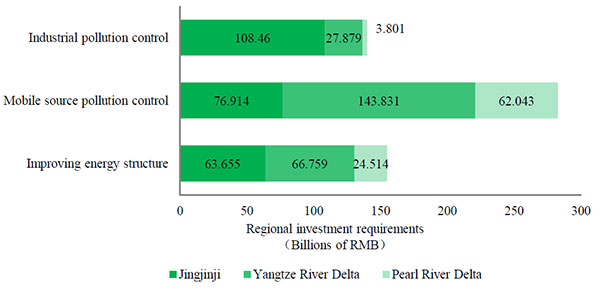
Estimated investment requirements in airborne pollution prevention and control in Jingjinji region, Yangtze River Delta region and Pearl River Delta region. (Photo from report)
They are energy structure optimization (such as closing down coal-fired boilers), prevention and control of pollution from mobile sources (such as developing new energy vehicles and oil upgrades), industrial sources (such as desulfurization and denitrification in heavy polluting factories) and non-point mobile sources (such as reducing dust from construction sites), which respectively require 284.4 billion yuan, 140.7 billion yuan, 91.5 billion and 61.6 billion yuan.
The investment put in prevention and control of pollution from mobile sources make up 76 percent of all required investment.
Although it requires a sizeable investment, reducing air pollution can stimulate economic growth.
Implementing the Control Action Plan is expected to increase China's GDP by 2.04 trillion yuan and create 2.9 million jobs over the course of five years.
It is also scheduled to exert a dramatic effect on people's health when PM 2.5 density goes down. By 2017, there would be a reduction of 110,600 chronic deaths per year in China and life expectancy would be extended by an average of 0.24-1.48 years for males and 0.34-3.48 years for females.
In September, the State Council issued an Integrated Reform Plan for Promoting Ecological Progress, which includes carrying out the Pilot Plan for Preparing Balance Sheets for Natural Resource Assets.
The Pilot Plan will quantify the liability and equity on natural resources exploitation and conservation and provide a basis for optimizing governmental and social investment, China Environment News reported.


















































